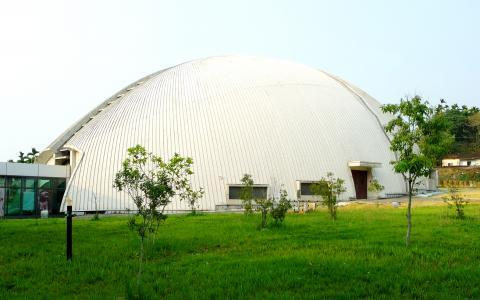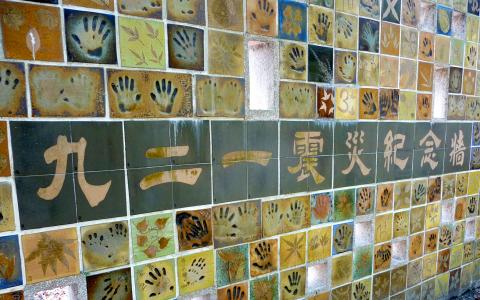Tomorrow will be the 20th anniversary of the most lethal earthquake to hit Taiwan since World War II.
The natural disaster that shook Taiwan in the early hours of Sept. 21, 1999 killed more than 2,400 people, injured more than 11,000 and caused property damage of more than NT$300 billion (US$10 billion).
A school in Taichung City wrecked by the earthquake was later converted into the 921 Earthquake Museum of Taiwan (921地震教育園區). The museum is deservedly popular as a destination for tourists and students. However, it’s not the only permanent site that marks the event. This article describes three less well-known locations that also commemorate the disaster.

Photo: Steven Crook
DOME OF THE FAULT
Before the 921 Earthquake, scientists had identified some sections of the Chelungpu Fault (車籠埔斷層), but for much of its length — thought to be at least 80km — it was hidden beneath collapsed hillsides or shale deposited by rivers.
During the quake, this non-vertical fault sprang back to life. The hanging wall was lifted to between 1m to 4m above the footwall. Houses directly above it were wrecked, but often the neighboring buildings were barely damaged.

Photo: Steven Crook
To better understand the geological processes involved, researchers excavated part of the exposed fault in Nantou County’s Jhushan Township (竹山鎮) after the disaster. The project came to resemble an archaeological dig, and faced some of the same challenges. It had to be protected from the elements, and in order to preserve it long-term as an educational site, a lightweight but weatherproof dome was built over it.
The dome now forms one part of Chelungpu Fault Preservation Park (車籠埔斷層保存園區). The other is a more conventional building filled with seismological instruments and displays about earthquakes and related topics. One of the highlights is a simulated hot-air balloon ride over Taiwan’s landscape.
There’s a good amount of English-language information in the museum, but I don’t think I would have fully grasped the significance of the various lines and layers that the excavation exposed, had it not been for a knowledgeable staff member. He explained everything, in English, with the aid of a laser pointer. Thanks to him, I left with a much better idea of the distortion and compression that makes this spot no ordinary piece of land.

Photo: Steven Crook
Directions
If you’re approaching the region via Freeway 3, take the Jhushan exit and you’ll see the park on the eastern side of Highway 3, where the off ramp joins the latter road. The park is open Tuesdays to Sundays, 9am to 5pm. Admission costs NT$50, but is free for local senior citizens and for entrances before 10am on Wednesdays.
CLAY-BAKED HANDPRINTS

Photo: Chen Hsin-jen, Taipei Times
The 921 Earthquake Memorial Wall (九二一震災紀念牆) is a private-sector tribute to those who were killed in the disaster. Sponsored by Tian Xing Kiln Ceramic Art Village (添興窯陶藝村), it consists of tiles in various colors on which visitors have imprinted their signatures, handprints and doodles before firing.
The wall has tactile as well as visual appeal. While there, I saw a family with two small children having great fun matching their hands with the different handprints.
Tian Xing Kiln was established in 1955, and for its first three decades it focused on the production of everyday items including roof tiles and flower pots. However, as house-building methods changed and plastics became more common, Tian Xing’s owners re-positioned the kiln as a tourism business.
Directions
If you’re coming from Jiji, the kiln and the wall are on the left-hand side of County Road 152, less than 700m east of Longcyuan Railway Station (龍泉車站), one of the stops on the Jiji Branch Railway.
BAMBOOZLED
For much of Taiwan’s post-war history, Jhongsing New Village (中興新村) was synonymous with the country’s unusual two-tier system of government.
To maintain the fiction that the Republic of China regime in Taipei was the rightful government of all China, and that Taiwan was but one of its provinces, in 1957 a separate provincial administration was established in this purpose-built suburb of Nantou City.
Some of the government buildings here were damaged beyond repair by the 1999 temblor. One plot was converted into the 921 Post-Earthquake Restoration Memorial Park (九二一重建感恩紀念公園). A design competition attracted 182 entries from 35 countries and territories, with the commission awarded to multinational firm Cheng Kim Park Robidoux.
NT$46 million (US$1.5 million) was spent on the park, more than originally budgeted. Reportedly, one reason for the cost overrun was that decision-makers didn’t listen to the advice of the plant experts they’d hired.
The original design included a patch of bamboo. “Without a particular entrance and guiding system, visitors stroll and get lost in the bamboo forest before they find the central void. The horror they experienced during the earthquake is melted down into the motion and phenomenology of the bamboo forest, whereas the central void is reinterpreted as an empty mind, where people find solace from the sky,” explains a website maintained by a former member of the winning team.
A bilingual map near the main road shows where the “forest of bamboo” and “sky-well” should be. However, after reportedly spending NT$2.6 million (US$85,000) on planting bamboo, it turned out the soil wasn’t suitable and drainage was inadequate — just as the project’s managers had been warned.
After repeated complaints from residents that the bamboo was yellow and wilting, another NT$2 million (NT$65,000) was allocated to cut it down and replace it with Korean lawngrass (Zoysia japonica).
The bamboo wall, a semi-underground walkway lined with bamboo sections, does exist as envisaged. The bamboos were intended as receptacles where visitors could place flowers to honor the dead.
However, the dark-gray ramp that accounts for a major part of the park’s land area is worse than mystifying. I can’t be the only person who looks at it and thinks of mass graves.
Directions
The park is on Guanghua Road (光華路) by the intersection with Shengfu Road (省府路) in Nantou City, where buses still halt at a stop labeled “In front of the Provincial Government” (省府前).
Steven Crook has been writing about travel, culture, and business in Taiwan since 1996. He is the co-author of A Culinary History of Taipei: Beyond Pork and Ponlai, and author of Taiwan: The Bradt Travel Guide, the third edition of which has just been published.

In the March 9 edition of the Taipei Times a piece by Ninon Godefroy ran with the headine “The quiet, gentle rhythm of Taiwan.” It started with the line “Taiwan is a small, humble place. There is no Eiffel Tower, no pyramids — no singular attraction that draws the world’s attention.” I laughed out loud at that. This was out of no disrespect for the author or the piece, which made some interesting analogies and good points about how both Din Tai Fung’s and Taiwan Semiconductor Manufacturing Co’s (TSMC, 台積電) meticulous attention to detail and quality are not quite up to

April 21 to April 27 Hsieh Er’s (謝娥) political fortunes were rising fast after she got out of jail and joined the Chinese Nationalist Party (KMT) in December 1945. Not only did she hold key positions in various committees, she was elected the only woman on the Taipei City Council and headed to Nanjing in 1946 as the sole Taiwanese female representative to the National Constituent Assembly. With the support of first lady Soong May-ling (宋美齡), she started the Taipei Women’s Association and Taiwan Provincial Women’s Association, where she

Chinese Nationalist Party (KMT) Chairman Eric Chu (朱立倫) hatched a bold plan to charge forward and seize the initiative when he held a protest in front of the Taipei City Prosecutors’ Office. Though risky, because illegal, its success would help tackle at least six problems facing both himself and the KMT. What he did not see coming was Taipei Mayor Chiang Wan-an (將萬安) tripping him up out of the gate. In spite of Chu being the most consequential and successful KMT chairman since the early 2010s — arguably saving the party from financial ruin and restoring its electoral viability —

It is one of the more remarkable facts of Taiwan history that it was never occupied or claimed by any of the numerous kingdoms of southern China — Han or otherwise — that lay just across the water from it. None of their brilliant ministers ever discovered that Taiwan was a “core interest” of the state whose annexation was “inevitable.” As Paul Kua notes in an excellent monograph laying out how the Portuguese gave Taiwan the name “Formosa,” the first Europeans to express an interest in occupying Taiwan were the Spanish. Tonio Andrade in his seminal work, How Taiwan Became Chinese,